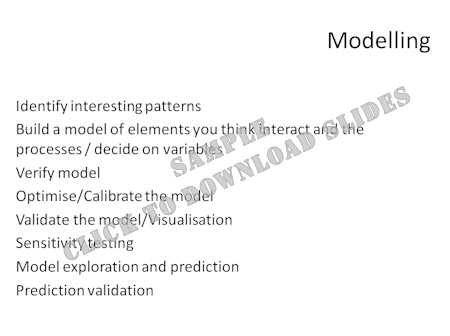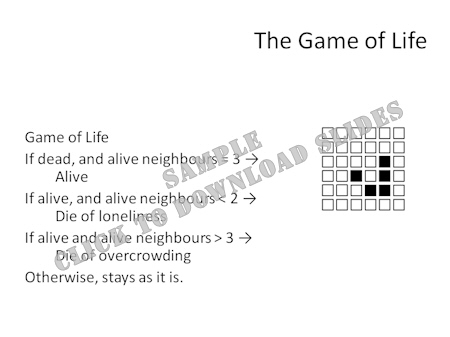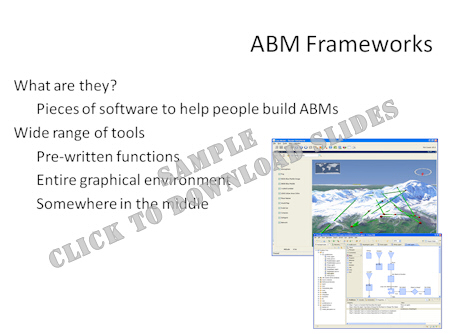Modelling: Introduction to (Agent-Based) Modelling
[Part 9 of 12]
In this part, and for the following three parts, we'll look at modelling. Although we'll be concentrating on generic aspects of modelling, we'll be taking as our example Agent-Based Models (ABMs). This is because ABMs are relatively simple to build, but very powerful. They are also likely to be one of the most important modelling techniques, both inside and outside of academia, over the next few years. To understand ABMs, we need to look at individual-based modelling more broadly, and we'll introduce the field in this part.
First up, a brief introduction to modelling. We'll come back to some of these themes in more detail in the next part.
Introduction to modelling (powerpoint)
Further info:
Di Paolo, E. A., Noble, J. and Bullock, S. (2000) Simulation models as opaque thought experiments. In: Seventh International Conference on Artificial Life, pp. 497-506, MIT Press, Cambridge, MA.
Next, we'll look at individual-based models, and Agent-Based Modelling more specifically. We'll start by looking at the foundations of ABM in Cellular Automata (CA) and also look at a specific ABM algorithm used in crowd modelling: flocking.
Further info:
Examples:
Further info on calculating the Sierpinski Gasket.
Conway's Game of Life at Wikipedia.
An applet for running Game of Life
Rudy Rucker's Game of Life++ Boppers.
Stephen Wolfram's website.
CA Fire models: Video and software.
Plague computing - the academic transport simulator TRANSIMS applied to disease spread with PriceWaterhouseCoopers. This bases its movements and populations on US census information.
Pheromone robotics.
The SIMs Homepage.
Some SIMs nuts and bolts for programmers.
SugarScape.
Robocode.
Task Gouda's 2D boids applet (you can also get the source code from here).
Queuing flocks.
Advanced flocks.
You can find Craig Reynolds’ website.
Boids video.
ABM and CA introduction (powerpoint)
CA workbook (word doc)
Papers:
Batty, M. (1992) Urban Modeling in Computer-Graphic and Geographic Information System Environments Environment and Planning, B, 19, p.678-708.
Deal, B. and Fournier, D.F. Ecological Urban Dynamics and Spatial Modeling, Construction Engineering Research Laboratory , University of Illinois.
Duarte, J.A.M.S. (1997) Bushfire Automata and Their Phase Transitions.
Int. J. Mod. Phys. C, 08, 171.
Macedonia, M. Using Technology and Innovation to Simulate Daily Life US Army US Army Simulation, Training, and Instrumentation Command, IEEE Computer Society.
Neumann von, John (1966), Theory of Self-Reproducing Automata, University of Illionois Press, Champain, IL (Summary)
Schelling, Thomas C. (1969) Models of Segregation in Strategic Theory and Its Applications, The American Economic Review, Vol. 59, No. 2, Papers and Proceedings of the Eighty-first Annual Meeting of the American Economic Association. (May, 1969), pp. 488-493.
Torrens, Paul M. How Cellular Models of Urban Systems Work (1. Theory) CASA Working Paper 28.
Carlson, Shawn ARTIFICIAL LIFE: Boids of a Feather Flock Together Scientific American.
Finally, we'll look at Netlogo, a simple software framework for building basic abstract ABM.
Further info:
Papers:
Railsback, Steven F., Steven L. Lytinen, and Stephen K. Jackson. (2006) Agent-based Simulation Platforms: Review and Development Recommendations. Simulation 82:9.
Tobias, Robert, and Carole Hofmann. (2004) Evaluation of free Java-libraries for social-scientific agent based simulation. Journal of Artificial Societies and Social Simulation 7(1).
Frameworks:


